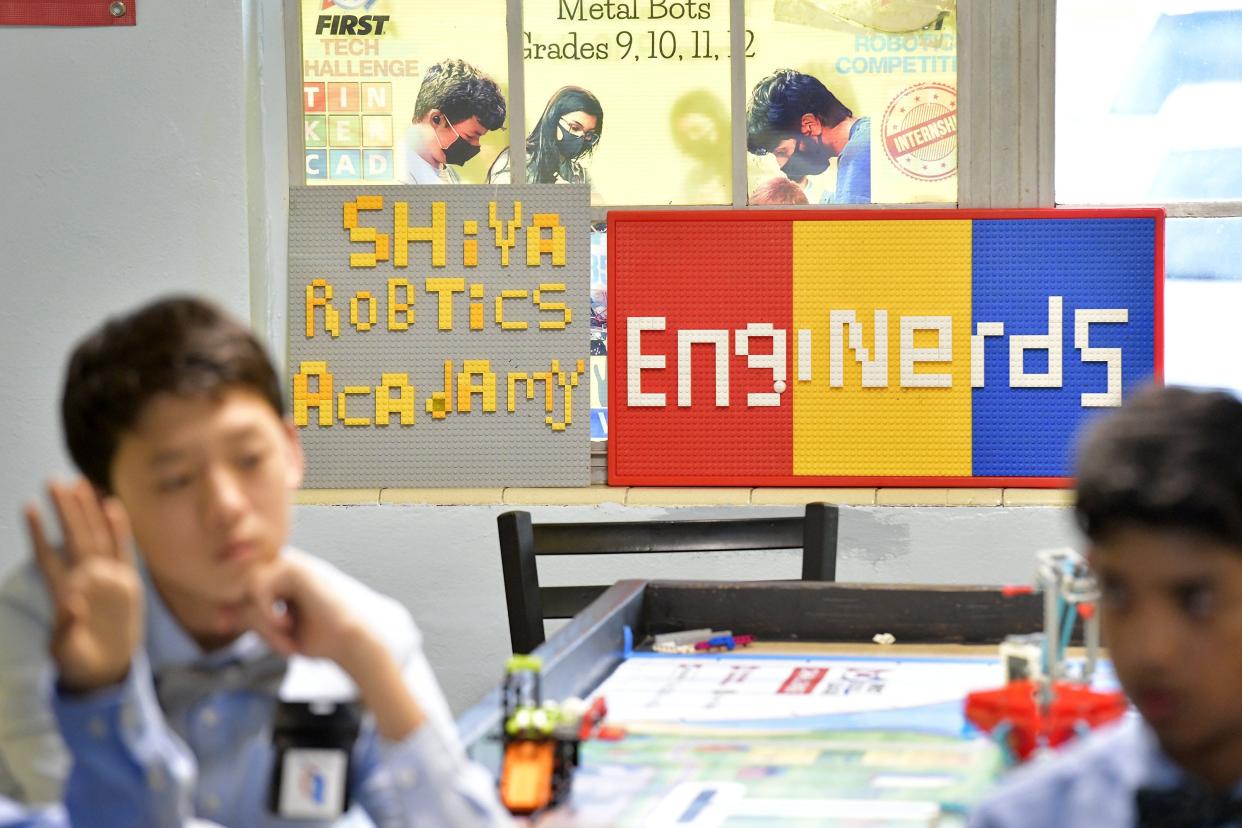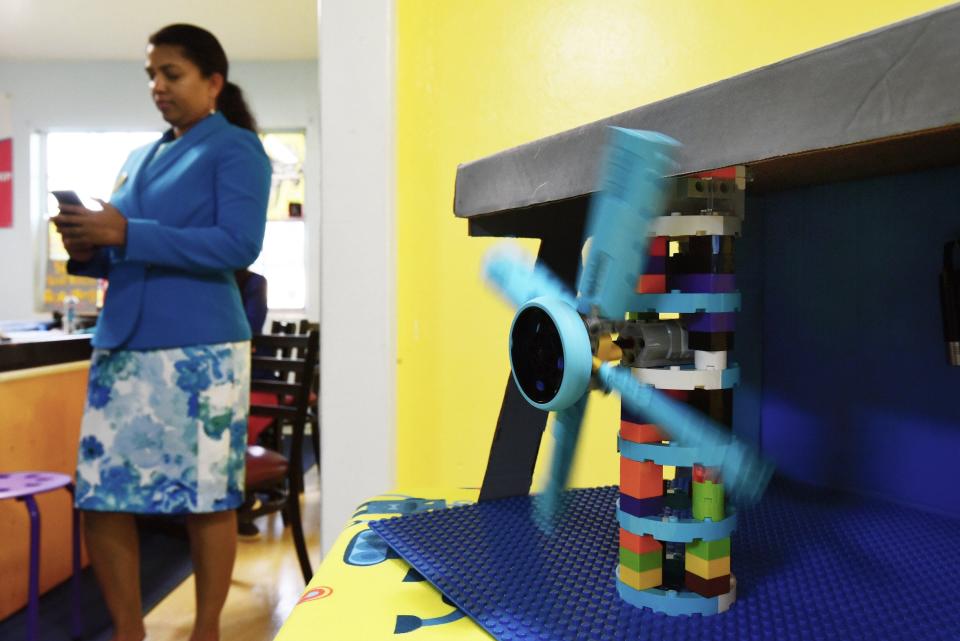Jacksonville robotics team sets eyes on World Championship, clean energy

City Council recently received a unique pitch as a push for renewable energy in Jacksonville: a hydroelectric generator, plated in cast iron, and attached to the posts on major piers with the ability to power homes along the coast.
Speaking softly and stretching toward the microphone on his tip-toes, 12-year-old John Stewart brought the group’s model forward – a colorful, mini, functioning prototype – made of Legos.
“[The generator] will be 100% renewable and it’ll be reliable and it will collect all the energy, or the potential energy, from the waves,” Stewart told the Times-Union.
Stewart is one of seven middle schoolers on the Shiva Robotics Academy First Lego League team. They call themselves the “EngiNerds.”
Last week we had the pleasure of welcoming this great group of students from the Shiva Robotics Academy to Council. They came to share their concept for creating energy using wind and reminded us all that the future is bright. #ilovejax pic.twitter.com/RV0ThiZUcn
— Terrance Freeman (@TFreemanJax) November 15, 2022
Between the ages of 10 and 12, Stewart, Claire Crum, Fletcher Farwell, Damian Kyrychenko, Dilan Patel, Trinity Eden and Aaron Huynh make up the team.
They come from different schools and financial situations, varying ethnicities and ages, united by a love of creating and robotics. Together, they developed a tool they think could promote clean energy in Jacksonville – and possibly earn them a spot in the First Lego League World Championship.
The competition tasked them with finding the solution to a real world problem through energy. In doing so, they furthered their coding skills, which they almost unanimously agreed was the hardest part, and hypothesized the effectiveness of other forms of renewable energy before deciding hydroelectric to be the best option.
Their idea, while interesting to see in Lego form, could be implemented – once technology catches up to them.
The students talked over Zoom with an engineer in Norway through The National Hydropower Association who told them their idea may have to wait just a while longer.
“It’s probably going to be the technology inside because you’re going to need to wire a lot of stuff if you’re going to power it back to the city,” Huynh said, who at 10 is the youngest member of the team. “So, I think what he’s saying is if we wait a couple years, maybe a couple more, and then we can implement this because we need high tech stuff.”
The generator is one of the models they will bring with them to a Lego robotics competition where they will be judged partially on the idea and execution, partly on the other, smaller energy-themed robots they designed and coded and, lastly, on how well they treat other competitors.
![Robotics student Trinity Eden, 11 looks on as Fletcher Farwell, 12 manipulates one of their team's robot creations Wednesday, November 16, 2022. Students at the Shiva Robotics Academy on Beach Blvd. have designed a plan for a hydroelectric generator that would attach to pier pilings. They have created a model using Legos and have been pitching the idea to City Council members and others who might have an interest in bringing their idea to fruition. [Bob Self/Florida Times-Union]](https://s.yimg.com/ny/api/res/1.2/CGMyvsolP75VToTCGe5Fcw--/YXBwaWQ9aGlnaGxhbmRlcjt3PTk2MDtoPTY0MQ--/https://media.zenfs.com/en/the-florida-times-union/7f7a68ede6271fadfc99b15633d4689f)
Why use Legos?
All the students had to qualify to be on the EngiNerds team. Kalai Sankar, the founder of Shiva Robotics Academy and affectionately called “Coach K,” structured the school to include several age groups of teams, starting with elementary students who learn the basics of coding, followed by group right behind the EngiNerds who build Lego robots based on pre-made designs but coded from scratch.
Sankar said starting with Legos and using the “Lego Education Curriculum” helps students learn the basics of building that can then be applied throughout their school and, eventually, professional careers.
The EngiNerds, the group for sixth to eighth graders, compete on their own ideas, designs and codes. From there, they can join the high school students in the Shiva program who use metal parts to build robots and with Java coding methods.
“To prepare to build a metal robot and to use Java coding, we had to use Lego as a stepping stone because Lego is easy to disassemble, to put it back and then it comes with sensors, motors and things like that,” Sankar said. “It's easy for the kids to learn hands-on building and coding.”
One of the EngiNerds coaches, Rushil Parikh, 15, opted against joining the high school team right away in order to focus on helping the EngiNerds.
“I really love Legos,” Parikh said. “That's why I got into this in the first place, and I still love Legos. I plan on joining the FRC team, the high school level team, within the next year, but I want to give back to the community and take a leadership position.”
Parikh was on the EngiNerds team when he was their age and even had the opportunity to go to a competition in Japan because of the team’s design – but like many plans made in early 2020, he didn’t get the chance.
The coronavirus pandemic halted his trip, but as a sophomore in high school now, he thinks giving back his time to the team has helped him grow as a leader and will help show colleges his dedication.

More than a competition
During their presentation to City Council, the students asked members for feedback on what they believed could be a project the city could actually undertake in the future.
A team just like the EngiNerds out of Virginia successfully advocated for their project last year. The team wanted to limit their community’s supply chain issues and developed a cargo container that could attach under school buses to be used for shipments outside of school hours, but state law did not allow buses to be used for anything other than transporting children.
Then, they met with a state senator who helped push through a bill to change the law, allowing for the implementation of their invention.
But, it all started with an idea and some Legos.
The EngiNerds want to have a similar effect in helping provide clean, green energy in Jacksonville through their “underwater windmill,” as 11-year old Eden, one of the two girls on the team, described it.
Coach K: It brings the community together
Sankar studied computer science in college but stepped away from programming and coding large projects when she had her two daughters. It was not until they entered elementary school when she began helping with their school projects that she dove back into the industry.
She became the assistant coach of their robotics team and took them to speak publicly about their projects – similarly to how the EngiNerds team did in November.
“I saw it [robotics] more like personality development for them,” Sankar said. “It gave them the confidence just like what you saw in City Council. … When I saw the benefits in my own daughters, I thought I should do it for their friends and then friends of friends.”
She started teaching out of her living room until she eventually founded the Shiva Robotics Academy about 10 years ago. Her daughters, one now in college with a STEM scholarship and the other in high school, were the “embodiment of bringing more girls into STEM,” she said.
When Sankar first started coaching, she rarely saw female coaches or competitors – much less students from outside affluent, private schools. She wanted to break those barriers in her own school.
She now partners with schools in the area through organizations like the Boys and Girls Club and Girl Scouts, introducing robotics and coding to around 700 students from elementary to high school. They go into Title I, public and private schools for after school programs and then offer discounts to attend Shiva Robotics Academy.
Students have left the program and gone on to earn major scholarships to attend the colleges “of their dreams,” she said.
“I consider that as my biggest accomplishment: to bring robotics and make it affordable and easily reachable for anybody to do, to learn technology because I have seen this has transformed the lives of several kids,” Sankar said.
The Lego competition offers scholarship money, Sankar said. To get there, the EngiNerds first have to qualify in January for the regional championships. Then, they could go to the world championship in Houston.
The team said they were “1,000%” excited about the world championship and loved working on their project. But, their favorite parts had nothing to do with robots.
The best part was, “Probably when we went to the trampoline park,” Stewart said.
“Either that or one time, there’s a playground outside, and we spent about 10 minutes just playing tag and eating skittles the whole time,” Patel agreed.
The team proudly showed off the school’s collection of Lego trophies and hoped to earn one themselves, but overall, they ultimately agreed the best part was learning and spending time with one another.
This article originally appeared on Florida Times-Union: Shiva Robotics First Lego League team prepares for competition

